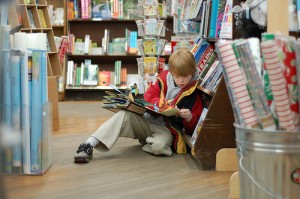By Phoebe Vreeland, The Children’s Book Review
Published: October 12, 2010
The New York Times recently ran an article entitled Picture Books No Longer a Staple for Children. It generated much discussion on the online comments page. Some readers were infected by the article’s tone that incited outrage: “Parents are pushing their children on to reading chapter books earlier so they can get a foot up at Harvard!” For others, it struck at the nostalgia of their childhood. These readers also reacted with sadness and fear: “Oh, no! Not the picture book, the beloved treasure of childhood! What will go next?” But for just as many—including librarians, who were not interviewed in the article—it was simply an unconvincing piece, basing a trend on too little information. The only parent quoted has spent much time online trying to clarify what she actually said.
Nonetheless, the article soared to the top of the New York Times‘ most emailed list. Huffington Post gave it ample coverage with headlines that read “Picture Books Getting the Heave-Ho”. Another headline read “Picture Books Unpopular with Over-zealous Parents: Are They Dying a Fast Death?” Author Alex Palmer presented an historical perspective with his piece “Adults Take the Fun Out of Reading, Again.” Blog writer Monica Edinger weighed in with her observations as a fourth grade teacher. To Ms. Edinger, reading is good whatever the genre – picture book, chapter book, even digital app. It’s all good. Yes, we can now read The Velveteen Rabbit on an iPad or even an iPhone when we tuck our babies in.
Whatever prompted the NY Times’ article, why did it create such a flurry? This interests me. Why are we so easily panicked and so quick to accept this as fundamental as children’s picture books are being kicked to the curb? Why aren’t we asking the experts about the subject? Surely librarians know what the “trends” are in literature. They have always been who I turn to when seeking guidance in choosing appropriate books for my child. While there are wonderful independent bookstores in our county, I visit when I can afford to and when I am ready to buy a book, these days we have a rule in our house: once a book has been checked out of the library twice, or once we find ourselves referring to the text or characters in our daily conversation and it has become a touchstone, then we buy it.
Although I whole–heartedly want to support not only the independent bookstores, but the artists and writers and publishers of children’s books. However, like many parents, I find myself needing to wait out the glut of “popular” book series. While I was amused by Pinkalicious the first time I read it, I have little interest in any of the other books in the series. Fancy Nancy crept into our house as a gift. I eventually hid the book because it had worn out its welcome when my daughter said “Ooooh la la!” and I no longer found it cute. I have to admit as much as I adore Knuffle Bunny, I am relieved (spoiler alert) that Trixie has outgrown it. I don;t only read the classics but bookshelves are pretty sacred to me and I carefully choose which books I want to own. I remember my mother telling me about her first date with my father and how she scanned the book titles on his shelves—apparently she liked what she saw.
Personally, what prompted me to start reading chapter books at bedtime to my four year-old was that I wanted a story that I could read in installments each night in bed. We could be held in suspense and eagerly anticipate the next chapter the following night. However, when the book had too much text and the subject matter was beyond her comprehension, I saw I was losing her. Then, we chose a simpler book.
I have no fear for the fate of picture books. Even when my daughter can read to herself, I know that we will still read picture books together. Good picture books offer art and poetry not just entertainment. Choose any classic picture book and you’ll see adults wax eloquent in reviews online. But beyond the well-chosen words, we love them for the art. I try to choose picture books with a variety of art work to encourage a broad appreciation of different art mediums. Kids need to learn to relate to pastel, charcoal, acrylic, wood-cut print, collage and watercolor picture as easily as cartoon—and the computer generated art of our age. This is another reason why the classic picture books will survive.
After reading the NY Times article, I attended a local elementary school fair held as a fund-raiser. In addition to the craft activities and bounce houses, there were dozens of tables of used books for sale. We spent almost an hour pouring through the discarded picture books and came home with a shopping bag full for five dollars. I felt like I had won the best prize at the fair. What made me truly happy was not finding many of the greats on that table. I imagine them safe in the family bookshelf or snapped up greedily by an earlier buyer. Many of the books my husband and I chose are as old as we are and we had to push aside plenty of discarded recent, trendy books to find them.
What picture books are a staple in your bookshelf? What is it about them that you treasure? Let’s celebrate this great form that talented writers and artists have given us and leave the fearful forecast behind.
Image courtesy of qwrrty.

